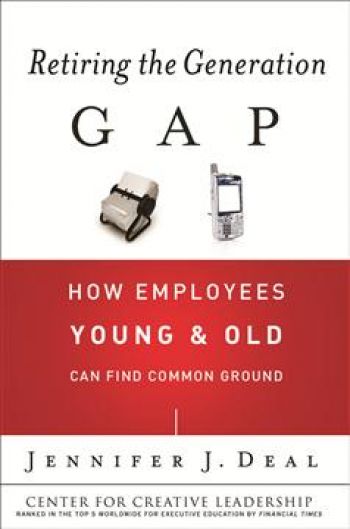What Generation Gap?
Book Review: Retiring the Generation Gap: How Employees Young & Old Can Find Common Ground by Jennifer J. Deal (Center for Creative Leadership/Jossey-Bass 2007)
- |
- Written by Joseph B. Frederick
- |
- Comments: DISQUS_COMMENTS
 Retiring the Generation Gap: How Employees Young & Old Can Find Common Ground by Jennifer J. Deal (Center for Creative Leadership/Jossey-Bass 2007)
Retiring the Generation Gap: How Employees Young & Old Can Find Common Ground by Jennifer J. Deal (Center for Creative Leadership/Jossey-Bass 2007)
Retiring the Generation Gap: examines the generation gap in the workplace and offers techniques for effectively managing generational differenc
The book is a product of the Center for Creative Leadership, but the insights brought forth apply to all who interact in a multi-generational work environment.
Using data obtained from thousands of interviews and surveys, author Jennifer Deal examines how employees of all ages view the workplace. She dispels generation gap myths, such as the stereotype of younger people being more adaptive to change than older workers. She puts conventional wisdom in perspective with factual data as she explains, for example, how tenure and higher status in an organization create loyalty, which is perceived as being age-driven, but in fact exists because younger workers are not usually found at the top.
Deal asserts that there are more similarities between the generations than differences, and that each generation has fundamentally the same values. However, behavior and expression of values differ between generations.
Deal offers ten principles which put the generation gap in a managerial context:
1. All generations have similar values
2. Everyone wants to be respected
3. Trust is important
4. People want leaders who are credible and trustworthy
5. Organizational politics is a problem for people of all ages
6. Most people are resistant to change
7. Loyalty depends on the context, not the generation
8. Effective management retains both young and older workers
9. Above all, everyone wants to learn
10. Most workers want a coach
Deal then offers suggestions for applying these principles in the work setting. She encourages readers to develop their own techniques in managing cross generational relationships. The reader will conclude that both generational similarities and differences are the source of conflict, and as we come to understand each other, we improve our effectiveness as managers, subordinates, and co-workers. As Coach John Wooden states:
“Stubbornness we deprecate,
Firmness we condone,
The former is our neighbor's trait,
The latter is our own.”
Understanding our differences begins with understanding they often are not all that different.
If you'd like to review books for our online book column, or have recently read a book that you found helpful that we haven't already reviewed, please e-mail [email protected]m
Want more banking news and analysis?
Get banking news, insights and solutions delivered to your inbox each week.
Tagged under Books for Bankers,













